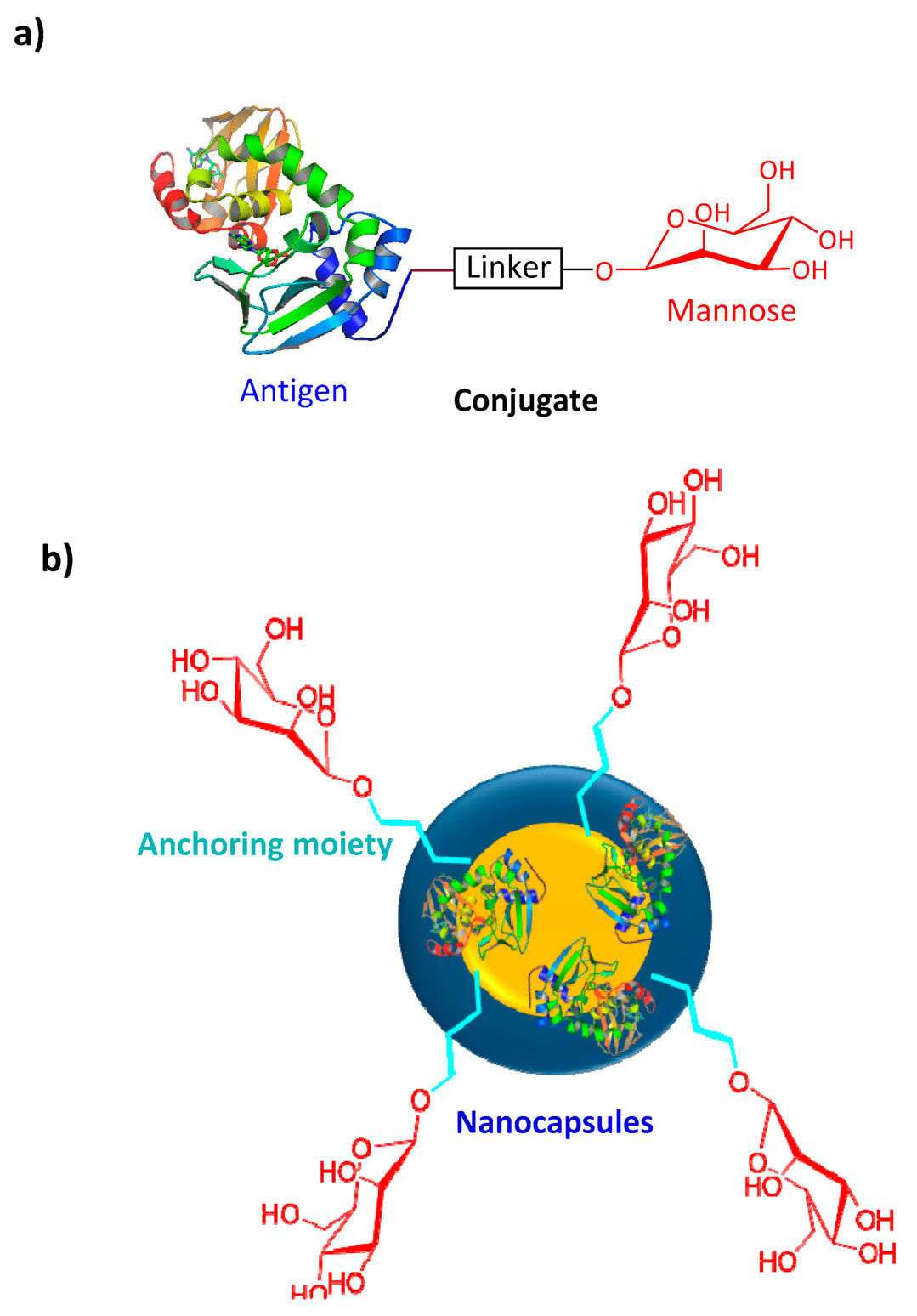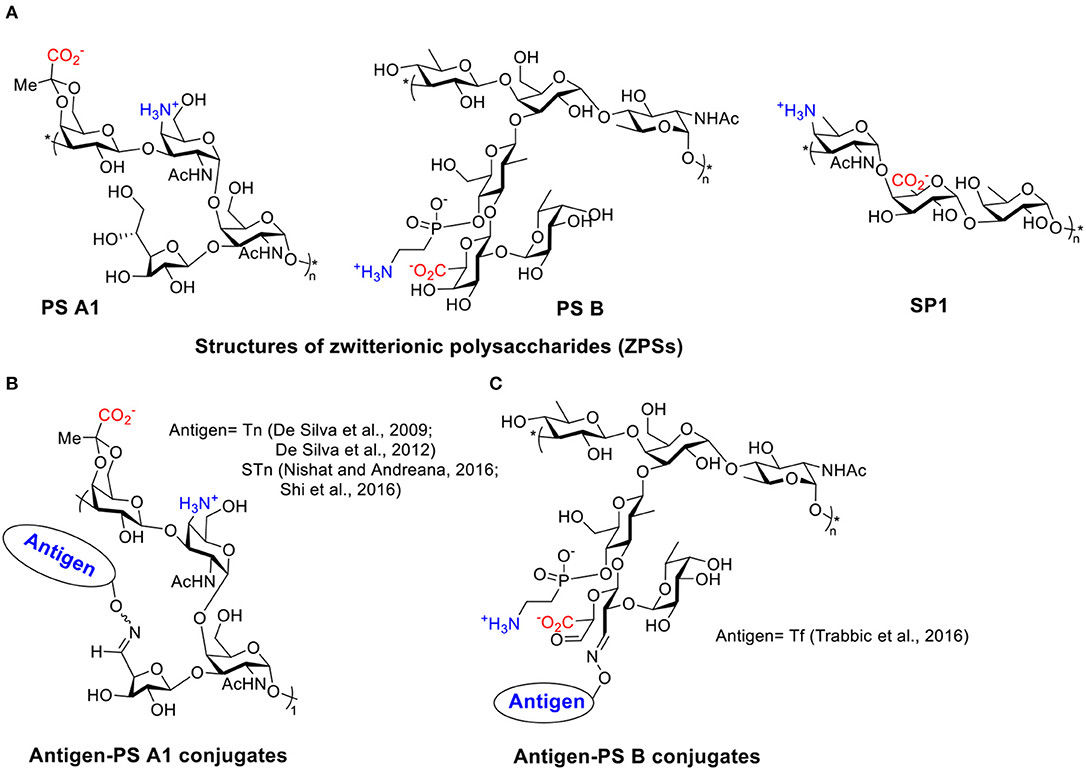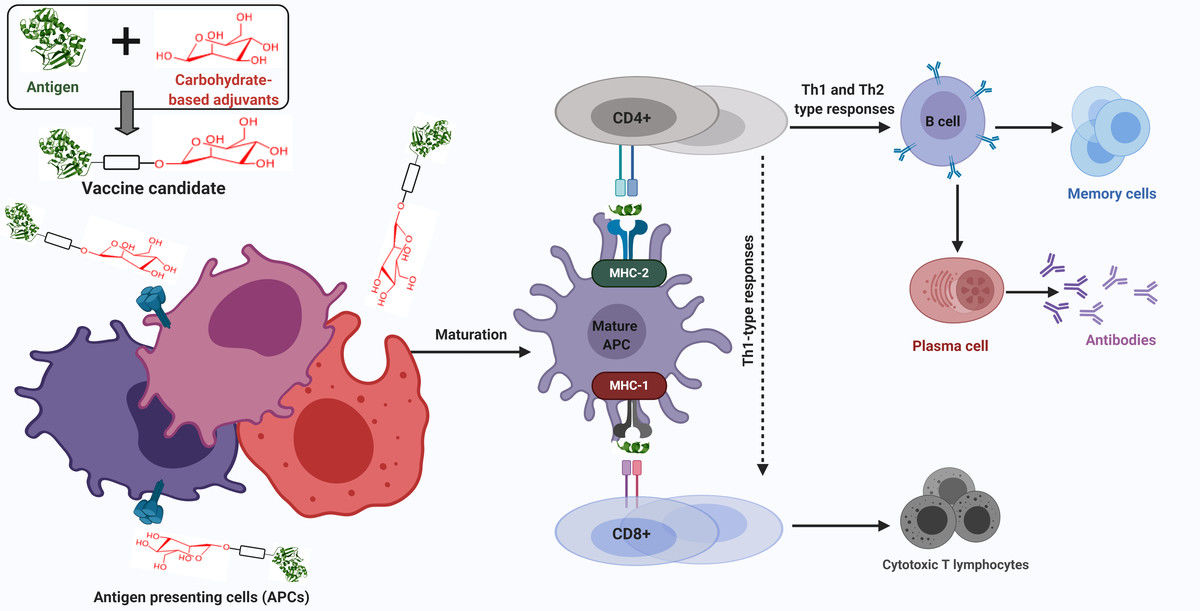Introduction to Carbohydrate Chains in Vaccines
Carbohydrate chains function as vital components for vaccine effectiveness within the complex pathogen-immune system interactions. The immune system uses carbohydrate chains from both glycoproteins and membrane proteins as essential elements to recognize pathogens and tumor cells in vaccines. Take viral vaccines for example, the glycosylation of viral surface proteins enhances their ability to bind to immune receptors, improving immune recognition and uptake by antigen-presenting cells (APCs) such as dendritic cells. Similarly, in bacterial vaccines, carbohydrate chains can help the immune system identify and mount an effective response against the bacteria. For instance, polysaccharide vaccines like PneumoVax, composed of capsular polysaccharides from various pneumococcal serotypes, are designed to protect against infections caused by these pathogens. However, these polysaccharides often fail to elicit robust antibody responses in high-risk groups, such as neonates, the elderly, and immunocompromised individuals. Creative Biolabs is at the forefront of exploring how glycosylation patterns influence both the development and the immune response to vaccines. We offer Custom Carbohydrate Antigen Synthesis Service for your research on carbohydrates in the development of vaccines.
 Fig.1 Mannosylated peptide/protein-based vaccine constructs.1,3
Fig.1 Mannosylated peptide/protein-based vaccine constructs.1,3
Carbohydrate Chain Modifications in Vaccines
The modification of carbohydrate chains in glycoproteins plays a critical role in the design of vaccine antigens. Glycans influence the conformation, stability, and immunogenicity of protein-based vaccines. Carbohydrate chain modification can be employed to optimize the immune response by enhancing the recognition of the antigen by immune receptors such as the C-type lectin receptors (CLRs), which are essential in the recognition of glycosylated structures on pathogens or vaccine antigens. To enhance immunogenicity, carbohydrate chains are frequently chemically modified. For example, zwitterionic polysaccharides (ZPS) can be altered to trigger T cell-dependent immune responses, which are more durable and potent than T cell-independent responses. Another instance is the N-propionylation of group B meningococcal polysaccharides to boost their immunogenicity. Conjugating carbohydrate chains to carrier proteins is a common strategy. For example, the first synthetic polysaccharide conjugate vaccine against Haemophilus influenzae type b (Hib), developed in Cuba, used a synthetic capsular polysaccharide antigen conjugated to tetanus toxoid. This approach has also been employed to create vaccines against pathogens like Streptococcus pneumoniae and Neisseria meningitidis. Through careful design of carbohydrate chains on glycoproteins, researchers can modulate the antigenicity of the vaccine, increasing its effectiveness.
 Fig.2 Structures of Zwitterionic Polysaccharides (ZPSs), antigen-PS A1 conjugates and antigen-PS B conjugates.2,3
Fig.2 Structures of Zwitterionic Polysaccharides (ZPSs), antigen-PS A1 conjugates and antigen-PS B conjugates.2,3
Carbohydrate Chain Modifications in Antigen Design for Vaccines
The design of antigens for vaccines is a meticulous process that requires strategic modifications to enhance their immunogenicity, stability, and specificity. One effective method is the modification of carbohydrate chains on glycoproteins, which significantly influences how the immune system recognizes and reacts to the antigen. Various glycan modification and labeling services offered by Creative Biolabs, such as fluorescence labeling, biotinylation, and PEGylation, play critical roles in optimizing antigen design and improving the efficacy of vaccines. We are dedicated in providing you Custom Carbohydrate Antigen Synthesis Service to facilitate your vaccine development.
|
Modification Type
|
Impact on Antigen Design and Vaccine Development
|
Examples and Applications
|
|
Fluorescence Labeling
|
- Enhances antigen tracking, visualization, and detection.
- Enables precise monitoring of immune responses.
|
- Used for labeling vaccine antigens to study their uptake by immune cells.
- Tracks vaccine delivery to specific tissues or cells during trials.
|
|
Biotinylation
|
- Facilitates easy binding of antigens to streptavidin-coated surfaces.
- Enhances antigen stability and immunogenicity.
|
- Essential for antigen purification, ELISA applications, and immunohistochemical studies.
- Ensures high-affinity binding and stability of the antigen during immune recognition.
|
|
PEGylation
|
- Prolongs the half-life of antigens in circulation by protecting against immune degradation and clearance.
- Enhances antigen stability and delivery.
|
- Widely used in DNA or protein-based vaccines to improve the delivery and pharmacokinetics of the vaccine.
- PEGylated antigens are more resistant to enzymatic breakdown, leading to longer-lasting immunity.
|
|
Isotope Labeling
|
- Allows precise tracking and quantification of vaccine antigens in clinical studies.
- Provides insights into antigen biodistribution and metabolism in the body.
|
- Isotope-labeled antigens are critical for studying the pharmacokinetics and biodistribution of vaccine candidates during pre-clinical and clinical studies.
|
|
Sulfate Modification
|
- Modifies antigen glycosylation to alter immune cell interactions.
- Enhances immune response through receptor-mediated uptake.
|
- Used in designing vaccines where specific glycan-receptor interactions are crucial, such as vaccines targeting immune cells.
- Enhances dendritic cell uptake for better antigen presentation.
|
|
Phosphorylation Modification
|
- Modifies the antigen's ability to engage with immune cell receptors.
- Enhances immune modulation and T cell activation.
|
- Can modulate immune response in vaccines by enhancing T cell-mediated immunity or regulating checkpoint proteins in cancer vaccines.
|
|
Acetylation Modification
|
- Alters the antigen's structure to improve solubility, stability, and immunogenicity.
- Influences how the antigen is recognized by immune cells.
|
- Acetylation is used to modify vaccine antigens for improved delivery to antigen-presenting cells (APCs).
- Enhances the overall immunogenicity of the vaccine candidate.
|
Carbohydrate Chains and Vaccine Delivery Systems
The success of a vaccine is not only determined by the antigen it carries but also by the efficiency with which that antigen is delivered to the immune system. Here, carbohydrate chains play a pivotal role in optimizing vaccine delivery, ensuring that the immune system is properly primed for defense. Whether it's a mRNA vaccine, DNA-based vaccine, or protein subunit vaccine, the method of delivery directly impacts the vaccine's effectiveness.
Carbohydrate Chains in Delivery Vectors
Delivery systems for vaccines are designed to protect the delicate vaccine components, help them navigate the body, and target them precisely to the immune cells that will best process the antigen. One of the most promising methods of delivery involves the use of lipid nanoparticles (LNPs), viral vectors, and liposomes, all of which can be modified with carbohydrate chains attached to phospholipids or proteins. These glycan structures on the surface of the delivery vehicles have a critical role in guiding the vaccine particles to the right cells and enhancing their uptake by immune cells.
Lipid nanoparticles, commonly used in mRNA vaccines like the Pfizer-BioNTech COVID-19 vaccine, are modified with carbohydrate chains attached to a phospholipid to ensure optimal interactions with the cell membrane. These carbohydrate residues serve as "signals" that promote cellular recognition and uptake via receptor-mediated endocytosis. Moreover, the presence of carbohydrate chains on glycoproteins found in the surface proteins of viral vectors can significantly enhance their targeting specificity. For example, when viral vectors are engineered with specific glycosylation patterns, they can bind more effectively to specific receptors on the surface of target cells. This ensures that the viral particles not only reach their intended destination but also evade immune recognition until the moment of delivery. The glycosylation of viral vectors can even help prevent rapid clearance from the bloodstream, thus increasing the vaccine's half-life and improving its overall efficacy.
Enhancing Vaccine Stability with Carbohydrate-Modified Systems
In addition to improving targeting, carbohydrate chains also enhance the stability of vaccines during storage and transportation—key factors for global vaccine distribution. Many vaccines, particularly protein-based vaccines, are sensitive to degradation due to environmental factors such as temperature and pH. Carbohydrates serve as stabilizers, helping to maintain the integrity of the vaccine components. For instance, the addition of specific sugar molecules to the formulation can protect fragile proteins and mRNA strands from denaturation, preventing the loss of their antigenic properties. These carbohydrate-modified systems improve the stability of the vaccine without the need for extreme cold storage, which has been a significant challenge for global vaccination efforts, particularly in low-resource settings.
The integration of carbohydrate chains in vaccine delivery systems is an exciting and dynamic area of research that has the potential to revolutionize vaccine technology. Whether enhancing stability, improving immune recognition, or enabling targeted delivery, these glycan structures are at the heart of the next generation of vaccines. Creative Biolabs, equipped with state-of-the-art glycan modification technologies, carbohydrate synthesis and carbohydrate analysis methods, is dedicated to advancing your carbohydrate-based vaccine design.
Carbohydrate Chains in Vaccine Efficacy and Immune Activation
Carbohydrate Chains on Membrane Proteins and Their Role in Immune Activation
Carbohydrate chains on membrane proteins are particularly important in mediating interactions with pattern recognition receptors (PRRs) on immune cells. For example, β-glucans can activate the CLR Dectin-1, leading to the activation of innate immune responses and the production of pro-inflammatory cytokines. Carbohydrate chains are not only essential for antigen recognition but also for immune activation. Another case indicates that, the glycan shield on a cluster of α1→2-linked mannose residues on the HIV envelope protein gp120 is targeted by broadly neutralizing antibodies (2G12), recognizing specific carbohydrate epitopes on the virus is of great importance of glycosylation in immune recognition and immune activation.
How Carbohydrate Chains Affect Vaccine Efficacy through Immune Activation
Carbohydrate chains can enhance vaccine efficacy by promoting immune activation. For example, glycoconjugate vaccines have been shown to provide long-lasting protection against bacterial infections by activating both innate and adaptive immune responses. The use of adjuvants like MPLA (monophosphoryl lipid A) can further enhance the immune response by targeting TLR4. Besides, carbohydrate-based adjuvants can activate various immune cells, triggering both Th1 and Th2 type immune responses. These responses lead to the activation of CD4+ and CD8+ T cells, the differentiation of B cells into plasma cells, and the production of antibodies and memory cells.
 Fig.3 Enhancing immune responses with carbohydrate-based adjuvants in vaccine development.1,3
Fig.3 Enhancing immune responses with carbohydrate-based adjuvants in vaccine development.1,3
References
-
Bashiri, Sahra, et al. "Carbohydrate immune adjuvants in subunit vaccines." Pharmaceutics 12.10 (2020): 965.
-
Lang, Shuyao, and Xuefei Huang. "Carbohydrate conjugates in vaccine developments." Frontiers in Chemistry 8 (2020): 284.
-
Distributed under Open Access license CC BY 4.0, without modification.
Related Services
Related Products
Resources
For Research Use Only.
 Contact Us
Follow us on
Contact Us
Follow us on

 Fig.1 Mannosylated peptide/protein-based vaccine constructs.1,3
Fig.1 Mannosylated peptide/protein-based vaccine constructs.1,3
 Fig.2 Structures of Zwitterionic Polysaccharides (ZPSs), antigen-PS A1 conjugates and antigen-PS B conjugates.2,3
Fig.2 Structures of Zwitterionic Polysaccharides (ZPSs), antigen-PS A1 conjugates and antigen-PS B conjugates.2,3
 Fig.3 Enhancing immune responses with carbohydrate-based adjuvants in vaccine development.1,3
Fig.3 Enhancing immune responses with carbohydrate-based adjuvants in vaccine development.1,3

